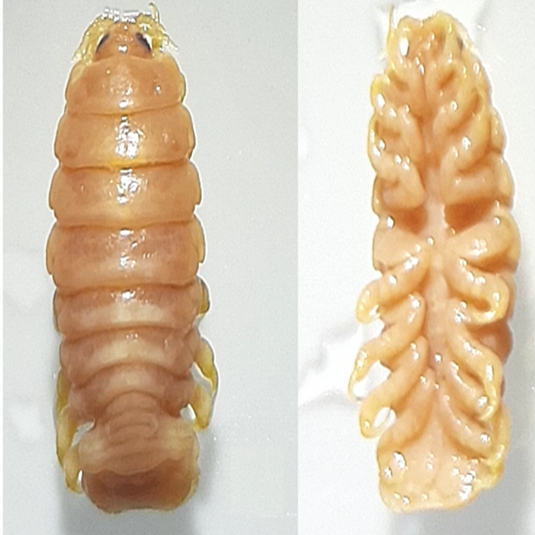Article Detail
Presence and potential threats of the cymotoid isopod Ceratothoa oestroides (Risso 1816) in meagre Argyrosomus regius (Asso, 1801) caught in Mersin Bay, Northeastern Mediterranean

Keywords:
Ceratothoa oestroides
Cymothoidae
Parasitic isopod
Argyrosomus regius
Northeastern Mediterranean
Abstract
This study investigates the detection of the parasitic isopod Ceratothoa oestroides (Risso, 1816) in meagre Argyrosomus regius (Asso, 1801) caught from the Paradeniz Lagoon (Mersin Bay) and the possible impact of this parasite on aquaculture. A review of the extant literature pertaining to the host species and distribution of the parasite was also conducted, with particular attention to the effects of the parasite on species farmed in the Mediterranean and Adriatic Seas. Drawing attention to the negative impact of this parasite on fish health and aquaculture and raising awareness about the precautions to be taken were also discussed. C. oestroides poses a grave threat to Mediterranean aquaculture, and as a critical resource for Mediterranean fish farms, the findings of this study are of great importance for the regional aquaculture sector.
References
- Bunkley-Williams, L., Williams, E. H. (1998). Isopods associated with fishes: a synopsis and corrections. Journal of Parasitology, 84(4), 893-896.
- Brusca, R. C. (1981). A monograph on the Isopoda Cymothoidae (Crustacea) of the eastern Pacific. Zoological Journal of the Linnean Society, 73(2), 117-199.
- Čolak, S., Kolega, M., Mejdandžić, D., Župan, I., Šarić, T., Piplović, E., Mustać, B. (2017). Prevalence and effects of the cymothoid isopod (Ceratothoa oestroides, Risso 1816) on cultured meagre (Argyrosomus regius, Asso 1801) in the Eastern Adriatic Sea. Aquaculture Research, 49(2),1001-1007.
- FAO. (2018). Species Fact Sheets: Argyrosomus regius. Available at: www.fao.org (05.02.25).
- Froese, R., Pauly. D. (Eds). (2024). FishBase. World Wide Web electronic publication. www.fishbase.org, version (12/2024).
- Gökpınar, S., Özgen, E. K., Yıldız, K. (2009). Ege Denizi’nin Kuzeyinden Yakalanan Bir Sarıgöz Balığında Ceratothoa oestroides (Risso, 1826) (Isopoda: Cymothoidae). Türkiye Parazitoloji Dergisi, 33(2), 188-190.
- Hadfield, K. A., Bruce, N. L., Smit, N. J. (2016). Redescription of poorly known species of Ceratothoa Dana, 1852 (Crustacea, Isopoda, Cymothoidae), based on original type material. ZooKeys, 592, 39-91.
- Horton, T., Okamura, B. (2001). Cymothoid isopod parasites in aquaculture: a review and case study of a Turkish sea bass (Dicentrarchus labrax) and sea bream (Sparus auratus) farm. Diseases of Aquatic Organisms, 46(3), 181-188.
- Horton, T., Okamura, B. (2003). Post-haemorrhagic anaemia in sea bass, Dicentrarchus labrax (L.), caused by blood feeding of Ceratothoa oestroides (Isopoda: Cymothoidae). Journal Fish Diseases, 26(7), 401-406.
- İnnal, D., Kırkım, F., Erkakan, F. (2007). The parasitic isopods, Anilocra frontalis and Anilocra physodes (Crustacea; Isopoda) on some marine fish in Antalya Gulf, Turkey. Bulletin-European Association of Fish Pathologists, 27(6), 239-241.
- Kırkım, F. (1998). Investigations on the systematics and ecology of the Aegean Sea isopoda fauna. Ege University, Science Institute, İzmir, p 238.
- Koyuncu, C., Ayas, D. (2024). Sand Steenbras Lithognathus mormyrus (Linnaeus, 1758), the New Host of the Parasitic Isopod Anilocra physodes (Linnaeus, 1758) from Mersin Bay, Northeastern Mediterranean. Tethys Environmental Science, 1(4), 193-199.
- Lester, R. J. G., Roubal, F. R. (1995). Phylum Arthropoda. In Woo, P. T. K. (Ed.), Fish Diseases and Disorders: Protozoan and Metazoan Infections (pp. 475-598). CAB International.
- Mladineo, I. (2002). Prevalence of Ceratothoa oestroides (Risso, 1826), a cymothoid isopod parasite, in cultured sea bass Dicentrarchus labrax L. on two farms in middle Adriatic Sea. Acta Adriatica, 43(1), 97-102.
- Ramdane, Z., Bensouilah, M. A. Trilles, J. P., (2007). The Cymothoidae (Crustacea, Isopoda), parasites on marine fishes, from Algerian fauna. Belgian Journal of Zoology, 137(1), 67-74.
- Rohde, K. (2005). Marine parasitology. CABI Publishing.
- Sadovy, Y., Cheung, W. L. (2003). Near extinction of a highly fecund fish: The one that nearly got away. Fish and Fisheries, 4(2), 86-99.
- Šarušić, G. (1999). Preliminary report of infestation by isopod Ceratothoa oestroides (Risso, 1826) in marine cultured fish.” Bulletin of the European Association of Fish Pathologists, 19(3), 110-112.
- Smit, N. J., Bruce, N. L., Hadfield, K. A. (2014). Global diversity of fish parasitic isopods of the family Cymothoidae. International Journal for Parasitology: Parasites and Wildlife, 3(2), 188-197.
- Turan, C., Ergüden, D., Gürlek, M., Doğdu, S. (2024). Checklist of Alien Fish Species in the Turkish Marine Ichthyofauna for Science and Policy Support. Tethys Environmental Science, 1(2), 50-86.
- Vagianou, S., Athanassopoulou, F., Rigos, G. (2006). Prevalence and pathology of ectoparasites of Mediterranean sea bream and sea bass reared under different environmental and aquaculture conditions. Israeli Journal of Aquaculture, 58(2), 78-88.
25
6745
57620
20days
50days
10days
